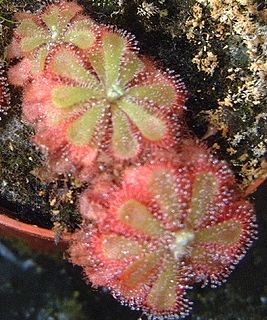Harold Ernest Robinson was an American botanist and entomologist.

The copper-rumped hummingbird is a species of hummingbird in the "emeralds", tribe Trochilini of subfamily Trochilinae. It is found in Tobago, Trinidad, Venezuela, and possibly Grenada.

Drosera aliciae, the Alice sundew, is a carnivorous plant in the family Droseraceae. It is native to the Cape Provinces of South Africa, like Drosera capensis, the cape sundew, and is one of the most common sundews in cultivation. The plant forms small, tight rosettes of wedge-shaped leaves, up to 5 cm in diameter. Under conditions of good lighting, the insect-snagging tentacles will become deeply coloured with anthocyanin pigments, which probably aid in its attraction of insect prey. The plant is relatively easy to grow, and produces attractive scapes of pink flowers, which are held about 30 cm away from the carnivorous leaves, so as to prevent pollinators from becoming ensnared. D. aliciae is very similar in form to a number of other closely related species such as D. slackii, and D. natalensis: the former is rather larger with a slightly different growth habit(8 cm diameter); the latter has hairier stipules and a larger distance between leaf base and the “sticky” trichomes.

Navia is a genus of plants in the family Bromeliaceae, containing 95 species. Described as early as 1830 in Guyana, they are commonly cultivated for their colorful foliage and inflorescences. All the species are native to northern South America.

Botanical illustration is the art of depicting the form, color, and details of plant species, frequently in watercolor paintings. They must be scientifically accurate but often also have an artistic component and may be printed with a botanical description in books, magazines, and other media or sold as a work of art. Often composed by a botanical illustrator in consultation with a scientific author, their creation requires an understanding of plant morphology and access to specimens and references.
Navia aloifolia is a species of plant in the genus Navia. This species is endemic to Venezuela.
Navia glandulifera is a plant species in the genus Navia. This species is endemic to Venezuela.
Navia immersa is a plant species, in the genus Navia.
Navia involucrata is a plant species in the genus Navia. This species, of the origin family Bromeliaceae, is endemic to Venezuela.
Navia latifolia is a plant species in the genus Navia. This species is endemic to Venezuela.
Navia octopoides is a plant species in the genus Navia. This species is endemic to Venezuela.
Navia pauciflora is a plant species in the genus Navia. This species is endemic to Venezuela. The specific epithet pauciflora is Latin for 'few-flowered'.
Navia pulvinata is a plant species in the genus Navia. This species is endemic to Venezuela.
Navia scirpiflora is a plant species in the genus Navia. This species is endemic to Venezuela.
Navia serrulata is a plant species in the genus Navia. This species is endemic to Venezuela.
Navia stenodonta is a plant species in the genus Navia. This species is endemic to Venezuela.
Navia terramarae is a plant species in the genus Navia. This species is endemic to Venezuela.
Navia umbratilis is a plant species in the genus Navia. This species is endemic to Venezuela.
Navia gleasonii is a plant species in the genus Navia. This species is native to Guyana and Venezuela.
Alice R. Tangerini is an American botanical illustrator. In 1972, Tangerini was hired as a staff illustrator for the Department of Botany at the National Museum of Natural History by American botanist Lyman Bradford Smith. Prior to working at the Smithsonian Institution, she received a Bachelor of Fine Arts from Virginia Commonwealth University. As of March 9, 2017, Tangerini remains the only botanical illustrator ever hired by the Smithsonian.



